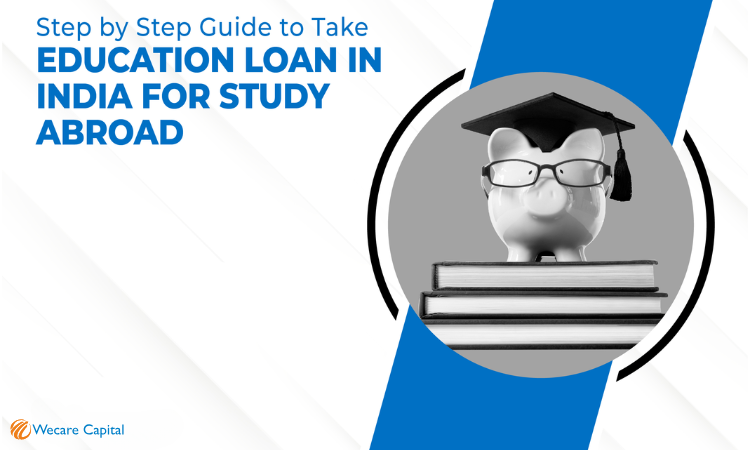Studying abroad is a dream for many students, but financing education in a foreign country can be challenging. Education loans play a crucial role in funding higher studies, and understanding abroad education loan interest rates is essential for making informed financial decisions. This guide will help you understand the different types of education loans, interest rates, factors affecting them, and how to secure the best loan for your studies abroad.
1. Understanding Abroad Education Loan Interest Rates
An abroad education loan interest rate is the percentage charged on the loan amount borrowed to finance education in another country. It determines the total repayment amount and varies based on the lender, loan type, and applicant’s financial profile.
Interest rates on education loans can be fixed or floating:
- Fixed Interest Rate: Remains constant throughout the loan tenure.
- Floating Interest Rate: Changes periodically based on the market.
Interest rates also depend on whether the loan is secured (with collateral) or unsecured (without collateral).
Read Full Article :- Wecare Capital
2. Types of Education Loans for Studying Abroad
Students can avail of two main types of education loans:
A. Secured Education Loans (With Collateral)
- These loans require collateral, such as property, fixed deposits, or other assets.
- They usually have lower interest rates compared to unsecured loans.
- Offered by government banks, private banks, and financial institutions.
B. Unsecured Education Loans (Without Collateral)
- No collateral is required.
- The loan is sanctioned based on the applicant’s financial profile, credit history, and co-applicant’s income.
- Generally, higher interest rates compared to secured loans.
3. Interest Rates of Major Banks & Financial Institutions (2024)
| Lender | Secured Loan Interest Rate | Unsecured Loan Interest Rate |
|---|---|---|
| State Bank of India (SBI) | 8.50% – 10.50% | 10.75% – 12.50% |
| HDFC Credila | 9.50% – 11.50% | 11.50% – 13.00% |
| ICICI Bank | 9.00% – 11.00% | 11.00% – 13.50% |
| Axis Bank | 9.25% – 11.75% | 11.50% – 14.00% |
| Bank of Baroda (BOB) | 8.75% – 10.75% | 10.50% – 12.75% |
| Avanse Financial | N/A | 12.50% – 14.00% |
| InCred | N/A | 11.75% – 14.50% |
| Prodigy Finance | N/A | 11.00% – 15.00% |
Note: Interest rates may vary based on the applicant’s creditworthiness, co-applicant details, and lender policies.
4. Factors Affecting Abroad Education Loan Interest Rates
The interest rate of an education loan depends on various factors, including:
A. Type of Loan
- Secured loans usually have lower interest rates as lenders have collateral as security.
- Unsecured loans come with higher interest rates due to the higher risk for lenders.
B. Loan Amount & Repayment Tenure
- Higher loan amounts often come with slightly higher interest rates.
- Longer repayment periods might increase the total interest paid over time.
C. Student’s Academic & Financial Profile
- A strong academic record can improve loan approval chances.
- Good credit history (or a financially stable co-applicant) can lead to lower interest rates.
D. Country & University Ranking
- Loans for students admitted to top-ranking universities may have lower interest rates.
- Countries with stable economies and high employment rates might offer lower rates.
E. Market Conditions & Repo Rates
- Interest rates fluctuate based on economic policies and market trends.
- Changes in repo rates by the Reserve Bank of India (RBI) can impact loan interest rates.
5. How to Get the Lowest Interest Rate on an Education Loan
To secure the best education loan interest rate, follow these steps:
A. Compare Loan Offers
- Research different lenders and compare interest rates, processing fees, and loan terms.
- Look for banks that offer subsidies and discounts.
B. Apply for a Secured Loan
- If possible, opt for a loan with collateral to get a lower interest rate.
C. Maintain a Strong Credit Score
- A CIBIL score above 750 improves loan approval chances at lower interest rates.
D. Choose a Co-Applicant with Good Financial Standing
- A financially stable co-applicant (parent/guardian) can help negotiate better rates.
E. Check for Government Subsidies & Scholarships
- Government schemes like Padho Pardesh, Dr. Ambedkar Interest Subsidy, and Vidya Lakshmi can reduce interest burdens.
6. Government Schemes for Interest Rate Subsidies
The Indian government offers various interest subsidies for students taking education loans:
| Scheme Name | Eligibility | Benefits |
|---|---|---|
| Padho Pardesh Scheme | Minority community students | Interest subsidy during the moratorium period |
| Dr. Ambedkar Interest Subsidy | OBC & EBC students | Full interest subsidy during moratorium |
| Vidya Lakshmi Scheme | All Indian students | Centralised loan application platform |
| Rinn Raksha Scheme | SBI education loan borrowers | Loan insurance at discounted rates |
Applying for these schemes can help students reduce their overall education loan burden.
7. Moratorium Period & Loan Repayment
Most education loans offer a moratorium period (grace period) of 6 months to 1 year after course completion. Interest accrued during this period may be:
- Simple interest (less costly)
- Compound interest (costlier over time)
To reduce interest burden:
- Start making partial interest payments during the moratorium.
- Choose a shorter repayment tenure for lower total interest.
8. Conclusion
Securing an education loan for studying abroad requires careful research and planning. Interest rates vary based on the lender, type of loan, and student profile. To get the best loan, compare multiple options, opt for secured loans if possible, and explore government interest subsidies. With the right approach, financing your dream education abroad can be a smooth and affordable process.




